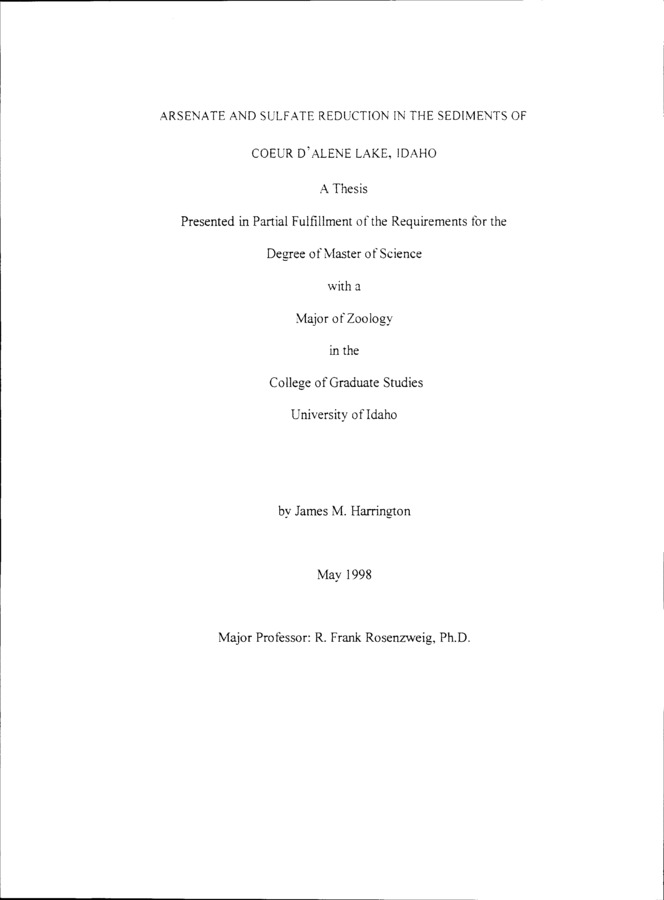PDF
Arsenate and sulfate reduction in the sediments of Coeur d'Alene Lake, Idaho Item Info
- Title:
- Arsenate and sulfate reduction in the sediments of Coeur d'Alene Lake, Idaho
- Authors:
- Harrington, James M.
- Contributors:
- Idaho Water Resources Research Institute; IWRRI
- Date:
- 1998-05
- Description:
- Sediments of Lake Coeur d'Alene, Idaho (CDAL) have been extensively contaminated with iron and trace elements from mining activities in the Coeur d'Alene mining district. Previous surveys of (CDAL) sediment have suggested the majority of the metals are bound in an oxide phase, and if true, contaminated water may result if anoxic conditions occur in the water column. In contrast, data from this study indicate that the majority of the iron and trace elements are bound in a sulfidic phase. Examination of the sediment pore waters shows iron and trace element concentrations to be more than federal drinking water standards. Strongly reducing conditions and an abundant microbial community are also present, indicating that reactions that occur under reducing conditions are predominant in CDAL sediments. In particular, sulfate-reducing bacteria (SRB) are abundant in CDAL sediments. Isolates of native SRB have the ability to form sulfides from soluble metal. In such conditions, metal solubility is low. indicating that SRB may act to mitigate the effects of metal contamination in CDAL. Arsenic shows some different trends as compared with other trace elements. Arsenic solubility is highest in redox potential between the ferric to ferrous couple and the sulfate to sulfide couple. As (III) is not sorbed as well to sediment components, and hence formation of reduced forms of arsenic may encourage arsenic mobilization in anoxic sediments. Bacterial transformations of arsenic have recently been shown to occur in sediments. In this study, arsenic reducing organisms were found to be less abundant than SRB, but still numerous. Additions of soluble As (V) to sediment microcosms were reduced to As (III). This reduction was stimulated by organic acids, and was inhibited by a respiratory inhibitor of SRB. These results suggest that SRB can form metal sulfides, and also mobilize arsenic by creating a reduced mobile form.
- Subjects:
- heavy metals mine wastes sediments water pollution
- Location:
- Lake Coeur d'Alene
- Idaho County:
- Kootenai County
- Latitude:
- 47.54
- Longitude:
- -116.82
- Collection:
- Coeur d'Alene Basin
- Source:
- University of Idaho
- Publisher:
- University of Idaho
- Contributing Institution:
- University of Idaho
- Type:
- Text
- Format:
- application/pdf
- Cataloger:
- wbv
- Date Digitized:
- 2012
- Language:
- eng
Source
- Preferred Citation:
- "Arsenate and sulfate reduction in the sediments of Coeur d'Alene Lake, Idaho", Idaho Waters Digital Library, University of Idaho Library Digital Collections, https://www.lib.uidaho.edu/digital/iwdl/items/iwdl-cda_harrington_1998.html
Rights
- Rights:
- In copyright, educational use permitted. Educational use includes non-commercial reproduction of text and images in materials for teaching and research purposes. For other contexts beyond fair use, including digital reproduction, please contact the University of Idaho Library Special Collections and Archives Department at libspec@uidaho.edu. The University of Idaho Library is not liable for any violations of the law by users.
- Standardized Rights:
- http://rightsstatements.org/vocab/InC-EDU/1.0/

